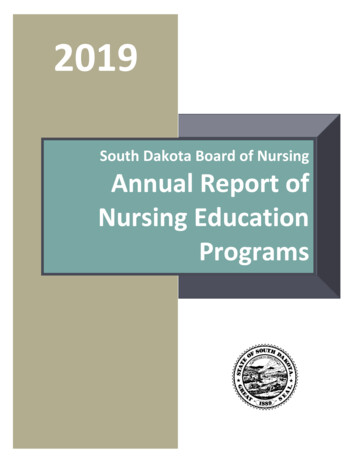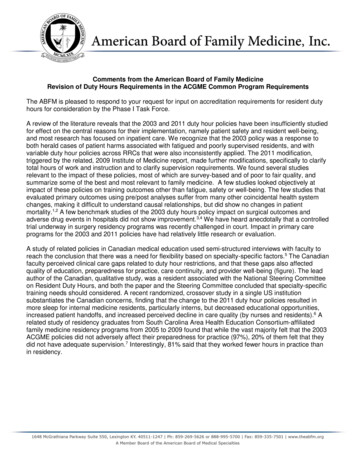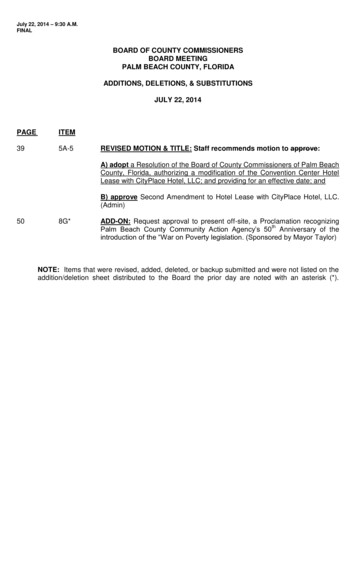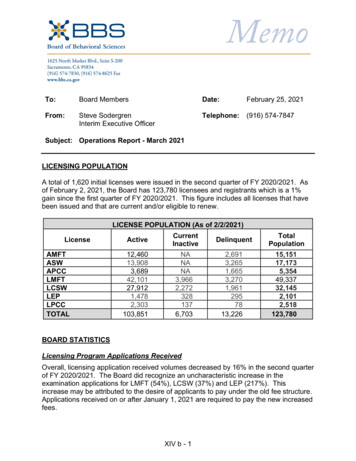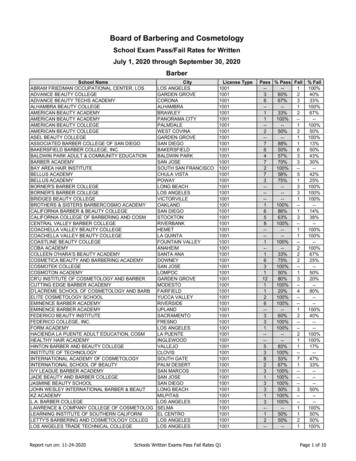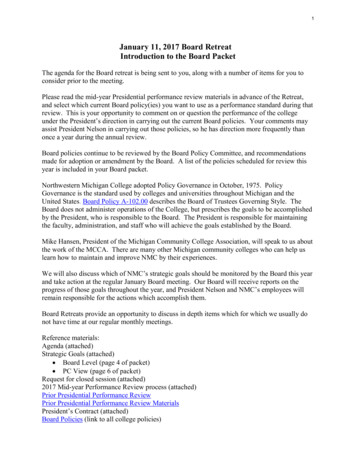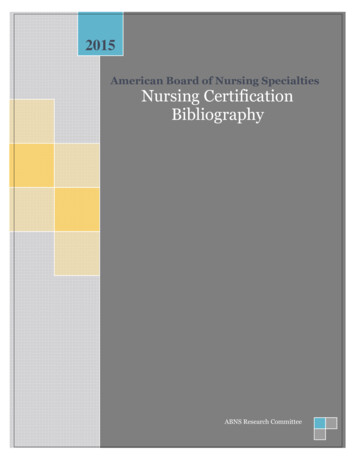
Transcription
2015American Board of Nursing SpecialtiesNursing CertificationBibliographyABNS Research Committee
Table of ContentsGeneral Information . 2Specialty Certification . 4Value of Certification . 8Role Delineation/Exam Development/Exam Blueprint . 11Advanced Practice Certification . 14Descriptive Studies . 17Patient Outcome Studies . 20Certification Preparation . 22Competency and Continuing Competence . 24General Interest . 26September 20151
General InformationAllen, D.E, & Girard, N.J. (1992). Attitudes toward certification: A pilot study. AORN Journal,55(3), 817-829.American Nurses Credentialing Center. (2002). The survey of the certifying organizations forRegistered Nurses in the United States. Washington, DC: American Nurses Publishing.Blais Gumpert, S. (2005). Certification dans une spécialité infirmière. Perspective infirmière, 2(3),34.Brown, J.D. (2013). Cost of certification: who bears the financial burden? MEDSURG Nursing, 22(5),335-336.Bulechek, G., & Maas, M. (1994). Nursing certification: A matter for the professionalorganization. In J. McCloskey & H. Grace (Eds.), Current Issues in Nursing - 3rd edition (pp.327-335). St. Louis: C.V. Mosby.DeSilets, L.D. (2007). Nursing professional development certification. The Journal of ContinuingEducation in Nursing, 38(1), 12-13.Faherty, B. (1991). Why bother getting certified? Home Healthcare Nurse, 9(4), 29-31.Fitzpatrick, M.A. (2003). Certified practice: We owe it to our patients and ourselves. NursingManagement, 34(3), 6.Flarey, D.L. (2000). Is certification the current gold standard? JONA, Healthcare, Law, Ethics,and Regulation, 2, 43-45.Fordham, P., & Martinez, J. (2005). Certificate vs. certification. Journal of Hospice & PalliativeNursing, 7(6), 305.Foster, C.W. (2012). Institute of Medicine The Future of Nursing Report, lifelong learning, andcertification. MedSurg Nursing, 21(2), 115-116.Jeffries, D. (2013). The public's perception of certification. Nephrology Nursing Journal, 40(3), 211216.Kenney, S., Ross, A., & Roberts, P.L. (2006). Certification and magnet hospitals. AmericanJournal of Nursing, 106(7), 74-76.Meyer, J. S. (1991). Registration, licensure, and certification: Understanding the value of each.Diabetes Educator, 17(1), 13.Miller, P. & Boyle, D. (2008). Nursing specialty certification: A measure of expertise. NursingManagement, October, 10-16.Miracle, V.A. (2007). Thinking about certification. Dimensions of Critical Care Nursing, 26(2), 72-75.September 20152
Parker, J. (1994). Development of the American Board of Nursing Specialties (1991-1993).Nursing Management, 25(1), 33-35.Ridenour, J. (2003). The role of nursing licensure and certification in society. Creative Nursing,9(2), 13.Ridge, R. (2008). Nursing certification as a workforce strategy. Nursing Management, August, 50-52.Roberts, D. (2004). ONC – The real magnet destination. Orthopaedic Nursing, 23(2), 100.Schenk, J.J., & Lewis, C.K. (1999). Credentialing: A paradox for the 21 st century. NursingLeadership Forum, 4(1), 14-17.Shirey, M. R. (2013). All nurses can benefit from certification. www.nurse.com. Dec. 6/112010001#.UsSe57SMml3Staul, L. (2011). Promoting certification – The chapter’s role. AACN Advanced Critical Care, 22(1),76-82.Winter, E.J.S., Pugh, L.C., & Riley-Giomarisa, O. (1992). Is certification for you? Nursing,22(1), 88-93.September 20153
Specialty CertificationAucoin, J. (2006). A comparison of the nursing professional development and the CertifiedNurse Educator Certification examination programs. Journal for Nurses in Staff Development,22(1), 44-45.Biel, M. (2000). The mission of the AACN Certification Corporation. In C.G. Schoon & I.L.Smith (Eds.), The licensure and certification mission (pp. 85-87). New York, NY: ProfessionalExamination Service.Budde, S.R. (2009). Safety certification – A path to job security and personal growth. AAOHNJournal, 57(1), 34-39.Burton, J. (2011). Certification for nurse educators and clinical educators. MedSurg Matters, 20(5), 1819.Chussil, J.T., Meyer, C., Vargo, N., Nankin, M., & Siegel, D.B. (1999). Development ofdermatology nursing certification. Dermatology Nursing, 11(5), 349-353.Clarke, S. (2007). Changing paediatric orthopaedic education and certification for the RN in NorthernIreland? Orthopaedic Nursing, 26(2), 126-129.Coleman, E., Frank-Stromberg, M., Hughes, L., Grindel, C., Ward, S., Berry, D., et al. (1999). Anational survey of certified, recertified, and non-certified oncology nurses: Comparisons andcontrasts. Oncology Nursing Forum, 26(5), 839-849.Critical Care Nurse. (2005). AACN new subspecialty certification exams. Critical Care NurseSupplement, 25, 38-39.Curley, M.A.C. (1998). Patient-nurse synergy: Optimizing patients’ outcomes. American Journalof Critical Care, 7(1), 64-72.Docken, L, & Sanders, C. (1999). Certification in infection control and epidemiology: Acelebration of 15 years! American Journal of Infection Control, 27(6), 514-519.Ferrell, B.R., Virani, R., Smith, S., & Juarez, G. (2003). The role of oncology nursing to ensurequality care for cancer survivors: A report commissioned by the National Cancer Policy Boardand Institute of Medicine. Oncology Nursing Forum, 30(1), E1-E11.Fetzer, S.J. (1997). Practice characteristics of the dual certificants – CPAN/CAPA.Perianesthesia Nursing, 12, 240-244.Garm, A. (2006). Promoting excellence in gerontological nursing. Nursingbc, February, 12-16.Gomez, N.J. (2013) Take action: certification. Nephrology Nursing Journal, 40(3), 193.Goodhart, J. & Page, J. (2007). Radiology nursing. Orthopaedic Nursing, 26(1), 36-39.September 20154
Grindel, C., & Roman, M. (2005). The medical-surgical nurse: Being a magnet for excellence.Medsurg Nursing Supplement, April, 4-34.Harrison, M. (2013). Reducing Barriers to Nursing Certification: An Analysis of Perceptions andImpact of PNCB’s No Pass, No Pay Program. Journal of Pediatric Nursing, 29(3), 212-219.Hartigan, C. (2004). Nurse certification and the Synergy Model. Excellence in NursingKnowledge, August-September.Hawkins, R., Bendickson, L., Benson, P., Osborne, L., McPherson, J., Todd, L., et al. (2014). A pilotstudy evaluating the perceptions of Certified Registered Nurse Anesthetists toward humanpatient simulation. AANA Journal, 82(5), 375-384.Head, B. (2001). Hospice and palliative nurse certification: Evolution of a nursing specialty.Journal of Hospice & Palliative Care, 3(4), 137-139.Hickey, J.V., Unruh, L.U., Newhouse, R.P., Koithan, M., Johantgen, M., Hughes, R.G., Haller, K.B.,& Lundmark, V.A. (2014). Credentialing: The need for a national research agenda. NursingOutlook, 62(2), 119-127. we, C. & Lowe, N.K. (2007). Certification and licensure in midwifery in Ament, L. ProfessionalIssues in Midwifery. Sudbury, MA: Jones and Bartlett.Infusion Nurses Society & Infusion Nurses Certification Corporation. (2009). The value ofcertification in infusion nursing – Joint INS/INCC Position Paper. Journal of Infusion Nursing,32(5), 248-250.Kancelbaum, B. (2010). Promoting certification in gerontological nursing. Nurse Leader, December,46-48.Leak, A. & Spruill, A. (2008). Oncology certification: What is in it for you? Clinical Journal ofOncology Nursing, 12(5), 703-704.Levesque, V. (1985). Specialization and certification: A review of CNA's activities. The CanadianNurse, 81(6), 26-28.Marshall, V. (2009). Benefits of Hospice and Palliative Care Certification. Home Healthcare Nurse,27(8), 463-467.Martinez, J.M. (2011). Hospice and palliative nursing certification – The journey to defining a newnursing specialty. Journal of Hospice & Palliative Care Nursing, 13(65), S29-S34.Mason, D.J. (2001). RN,C: What’s in a letter? American Journal of Nursing, 101(1 part 1), 7.Matzo, M., & Goetschius, S.K. (1993). Preparing for gerontological nurse certification. NursingHomes: Long Term Care Management, 42(5), 22-24.September 20155
McClain, N., Richardson, B., & Wyatt, J.S. (2004). A profile of certification for pediatric nurses.Pediatric Nursing, 30(3), 207-211.Muckle, T.J., Apatov, N.M., & Plaus, K. (2009). A report on the CCNA 2007 Professional PracticeAnalysis. AANA Journal, 77(3), 181-189.Nance, J.A. (1999). Professional development initiative. Professional certification in orthopaedicnursing. Orthopaedic Nursing, 18(1), 48-52.Nick, J.M., Sharts-Hopko, N.C, & Woodard Leners, D. (2103). From committee to commission: thehistory of the NLN's academic certified nurse educator program. Nursing EducationPerspectives, 34(5), 298-302.Niebuhr, B. (1993). Credentialing of critical care nurses. AACN Clinic Issues in Critical CareNursing, 4(4), 611-616.Nielsen, B.B., Laszlo, J., Miaskowski, C., Heusinkveld, K., Hogan, C., Jenkins, J., et al. (1990).Certification of oncology nurses: Maturing of a discipline. Journal of Cancer Education, 5(3),99-102.Nursing Management. (2005). Sorting out medical/surgical nursing certifications. NursingManagement Supplement, 36, 20-21.Oncology Nursing Society. (2004). Oncology certification for nurses. Oncology Nursing Forum,31(3), 491-492.Ortelli, T. (2008). Characteristics of candidates who have taken the Certified Nurse Educator (CNE)examination: A two year review. Nursing Education Perspectives, 29(2), 120-121.Ortelli, T. A. (2012). Evaluating the knowledge of those who teach: An analysis of candidates’performance on the Certified Nurse Educator (CNE) examination. (Doctoral dissertation).Patry, L. (2011). Certification comes of age. Canadian Nurse, 32-36.Pope, B. (2002). Working together to meet patient and family needs. Nursing, 32(7), 32-33.Rashotte, J. (2003). How will certification in critical care be of benefit to an organization? Dynamics,14(1), 14.Schmal, B.A. & Derrevere, S.K. (2012). The vital role of professional certification. Journal of Hospice& Palliative Nursing, 14(3), 177-181.Selekman, J., & Bowden, V.R. (1999). Certification opportunities for pediatric nurses. PediatricNursing, 25(5), 547-554.Sharoff, L. (2008). Holistic nursing and medical-surgical nursing: A natural integration. MEDSURGNursing, 17(3), 206-208.September 20156
Simpson, R. (1995). Nursing informatics certification. Nursing Management, 26(12), 49-50.Smith, K., & Bickford, C. (2004). Lifelong learning, professional development and informaticscertification. CIN: Computers, Informatics, Nursing, 22(3), 172-178.Stobinski, J.X. (2015). Certification and patient safety. AORN Journal, 101(3), 375-378.Tenney, J., Golden-Baker, S.B., DeMoucell, P.J., & Wians, K.M. (1993). Empowerment throughrehabilitation nursing certification. Rehabilitation Nursing, 18(4), 231-236.Trossman, S. (2002). What do credentials mean to you? Nurses talk about the value of ANCCcertification. American Journal of Nursing, 102(5), 71-73.Wartew, D.G. (2003). Certification with pride and respect. Medsurg Nursing, 12(5), 331.Weinstein, S.M. (2000). Certification and credentialing to define competency-based practice.Journal of Intravenous Nursing, 23(1), 21-28.Williams, H.F., & Counts, C.S. (2013). Certification 101: the pathway to excellence. NephrologyNursing Journal, 40(3), 197-253.Wiseman, K.C. (2013). Nephrology certification: what is it? Nephrology Nursing Journal, 40(3), 241246.Wood, M., & Joyce, J. (2008). Preparing for certification: Halifax nephrology nurses – in quest forexcellence. The CANNT Journal, 18(3), 50-51September 20157
Value of CertificationAlspach, G. (2003). The value of certification as a critical care nurse. Critical Care Nurse, 23(5),8-10.Altman, M. (2011). Let's get certified: Best practices for nurse leaders to create a culture ofcertification. AACN Advanced Critical Care, 22(1), 68-75.American Association of Critical-Care Nurses, AACN Certification Corporation. (2003).Safeguarding the patient and the profession: The Value of critical care nurse certification.American Journal of Critical Care, 12(2), 154-164.American Board of Nursing Specialties. (2006). Specialty nursing certification: Nurses’perceptions, values and behaviors. ABNS White Paper. Available atwww.nursingcertification.org/pdf/white paper final 12 12 06.pdfBarbe, T. (2015). Preliminary psychometric analysis of the modified Perceived Value of CertificationTool for nurse educators. Nursing Education Perspectives, 36, 244-248.Bekemeier, B. (2007). Credentialing for public health nurses: Personally valued but not wellrecognized. Public Health Nursing, 25(5), 439-448.Biel, M. (2007). Infusion nursing certification – Identification of stakeholders and demonstrationof the value of certification. Journal of Infusion Nursing, 30(6), 332-338.Briggs, L.A., Brown, H., Kesten, K., & Heath, J. (2006). Certification: A benchmark for criticalcare nursing excellence. Critical Care Nurse, 26(6), 47-53.Brown, C.G., Murphy, C.M., Norton, V., Baldwin, P.D. & Ponto, J. (2010). The value of oncologynursing certification. Clinical Journal of Oncology Nursing, 14(6), 707-712.Byrne, M., Valentine, W., & Carter, S. (2004). The value of certification – A research journey.AORN Journal, 79(4), 825-835.Cliff, B., & Martinez, J. (2004). Value of nursing certification. Journal of Hospice & PalliativeNursing, 6(3), 191-192.Critical Care Nurse. (2007). Advantages of certification. Critical Care Nurse Supplement, 27,36-38.Eisemon, N., & Cline, A. (2006). The value of certification. Gastroenterology Nursing, 29(6),428-430.Fleischman, R.K., Meyer, L., & Watson, C. (2011). Best practices in creating a culture of certification.AACN Advanced Critical Care, 22(1), 33-49.Gaberson, K.B., Schroeter, K., Killen, A.R., & Valentine, W.A. (2003). The perceived value ofcertification by certified perioperative nurses. Nursing Outlook, 51(6), 272-276.September 20158
Gladfelter, J. (2006). Nursing certification: Why it matters. Plastic Surgical Nursing, 26(4), 208210.Grief, C.L. (2007). The perceived value of BCEN certification. Journal of Emergency Nursing, 33(3),214-216.Haskins, M., Hnatiuk, C.N, & Yoder, L.H. (2011). Medical-Surgical nurses’ perceived value ofcertification study. MedSurg Nursing, 20(2), 71-77, 93.Head, B.A., & Myers, J. (2013). Differences between certified and noncertified hospice and palliativenursing assistants. Journal of Hospice & Palliative Nursing, 15(2), 89-98.Joachim, G. et al. (2001). The Relative Value of Nursing Work: A Study in Progress. NursingLeadership, 16(2), 51-61.Kaplow, R. (2011). The value of certification. AACN Advanced Critical Care, 22(1), 25-32.Knudson, L. (2013). Nursing certification provides recognition for nurses, employers. AORNConnections, 97(3), C1-C10.Lundmark, V. (2015). Starting a national conversation. The IOM Workshop on the future directions ofcredentialing research in nursing. JONA, 45(1), 1-3.McLaughlin, A., & Fetzer, S.J. (2015). The perceived value of certification by Magnet and nonMagnet Nurses. JONA, 45(4), 194-199.Mee, C. (2004). Certification? Just do it. Nursing, 34(9), 6.Messmer, P.R., Hill-Rodriguez, D., Williams, A., Ernst, M.E., & Tahmooressi, J. (2011). Perceivedvalue of national certification for pediatric nurses. The Journal of Continuing Education inNursing, 42(9), 421-432.Miracle, V.A. (2002). The importance of certification. Dimensions of Critical Care Nursing,21(3), 120.Niebuhr, B.M. (1994). The value of certification in a patient-driven healthcare system. Journalof Intravenous Nursing, 17(1), 20-24.Niebuhr, B. & Biel, M. (2007). The value of specialty nursing certification. Nursing Outlook,55(4), 176-181.ONCC Research Committee and Executive Staff. (1999). Report of a state-of-the-knowledgeconference on U.S. nursing certification. Image: Journal of Nursing Scholarship, 31(1), 51-55.Prowant, B.F., Niebuhr, B., & Biel, M. (2007). Perceived value of nursing certification –Summary of a national survey. Nephrology Nursing Journal, 34(4), 399-402.September 20159
Ridge, R. (2008). Nursing certification as a workforce strategy. Nursing Management, August.Sechrist, K.R., & Berlin, L.E. (2006). Psychometric analysis of the Perceived Value ofCertification Tool . Journal of Professional Nursing, 22(4), 248-252.Sechrist, K.R., Valentine, W., & Berlin, L.E. (2006). Perceived value of certification amongcertified, non-certified, and administrative perioperative nurses. Journal of ProfessionalNursing, 22(4), 242-247.Shirey, M. (2005). Celebrating certification in nursing. Nursing Administration Quarterly, 29(3),245-253.Spetz, J. (2014). Nurse credentials: What is the economic value? Nursing Economics, 32(5), 268-269.Tahan, H. (2005). Clarifying certification and its value for case managers. Lippincott’s CaseManagement, 10(1), 14-21.Tschirhart, M., Lee, C., & Travinin, G. (2013). The Benefits of Credentialing Programs toMembership Associations. ASAE Foundation Research Series.Trossman, S. (2002). What do credentials mean to you? Nurses talk about the value of ANCCcertification. American Journal of Nursing, 102(5), 71-73.Wade, C.H. (2009). Perceived effects of specialty nurse certification: A review of the literature. AORNJournal, 89(1), 183-192.Watts, M.D. (2010). Certification and clinical ladder as the impetus for professional development.Critical Care Nursing Quarterly, 33(1), 52-59.Williams, H.E., Lopez, G., & Lewis, K. (2013). Certification--good for business. Nephrology NursingJournal, 40(3), 247-253.Woods, D.K. (2002). Realizing your marketing influence, part 3: Professional certification as amarketing tool. Journal of Nursing Administration, 32(7/8), 379-386.September 201510
Role Delineation/Exam Development/Exam BlueprintAnderson, C.M., Raudonis, B.M., & Kirschling, J.M. (1999). Hospice and palliative nursing roledelineation study: Implications for certification. Journal of Hospice & Palliative Nursing, 1(2),45-55.Baghi, H., Panniers, T.L., & Smolenski, M. (2007). Description of practice as an ambulatory carenurse: Psychometric properties of a practice-analysis survey. Journal of Nursing Measurement,15(1), 62-74.Barnsteiner, J.H., Wyatt, J.S., & Richardson, V. (2002). What do pediatric nurses do? Results ofthe role delineation study in Canada and the United States. Pediatric Nursing, 28(2), 165-170.Becker, D., Kaplow, R., Muenzen, P., & Hartigan, C. (2006). Activities performed by acute andcritical care advanced practice nurses: American Association of Critical-Care Nurses study ofpractice. American Journal of Critical Care, 15(2), 130-148.Berger, N.K., Carr, J.J., Erickson, J., Gourash, W., Muenzen, P., Smolenak, L., et al. (2010). Path tobariatric nurse certification: The practice analysis. Surgery for Obesity and Related Diseases, 6,399-407.Biel, M., Eastwood, J. Muenzen, P., & Greenberg, S. (1999). Evolving trends in critical carenursing practice: Results of a certification role delineation study. American Journal of CriticalCare, 8(5), 285-292.Bjerke, N.B., Fabrey, L.J., Johnson, C.B., Benner, G., Schollenberger, D., Jacobsen, D., et al.(1993). Job analysis 1992: Infection control practitioner. American Journal of
Infusion Nurses Society & Infusion Nurses Certification Corporation. (2009). The value of certification in infusion nursing – Joint INS/INCC Position Paper. Journal of Infusion Nursing, 32(5), 248-250. Kancelbaum, B. (2010). Promoting certification in gerontological nursing. Nurse Le


